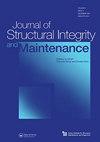Probabilistic deterioration modeling of bridge component condition with random effects
IF 3.1
Q2 ENGINEERING, CIVIL
Journal of Structural Integrity and Maintenance
Pub Date : 2022-06-17
DOI:10.1080/24705314.2022.2048244
引用次数: 5
Abstract
ABSTRACT Timely maintenance of bridge components is critical for bridge management functions. With reliable deterioration models, highway agencies can efficiently allocate funding for bridge maintenance and customize maintenance schedules to meet agency budgets. The increased public expectation of acceptable levels of service for bridges coupled with other competing needs makes it crucially important to accurately estimate bridge future conditions so that adequate resources may be allocated for repair and reconstruction purposes. Accurately predicting bridge condition is challenging due to the inherent random nature of factors impacting deterioration, the existence of unobserved variables that are not measured, panel nature of the data and the effects of bridge-specific correlation. Without accounting for these factors, the resulting estimated deterioration models may have biased and inconsistent parameter estimates. This article assembled a comprehensive set of bridge and climate data from the National Bridge Inventory (NBI) and the South Carolina Climatology office. Bridge component deterioration models for bridges on state highways in South Carolina were estimated using an ordered probit model with random effects specification to account for the randomness and panel nature of the bridge data. The study results are useful for various bridge management tasks including maintenance programming, budgeting and bridge asset evaluation.随机影响下桥梁构件状态的概率劣化建模
及时维护桥梁构件对桥梁管理功能至关重要。有了可靠的老化模型,公路机构可以有效地分配桥梁维修资金,并定制维修计划以满足机构预算。公众对桥梁可接受的服务水平的期望越来越高,再加上其他相互竞争的需求,这使得准确估计桥梁未来的状况变得至关重要,以便为修复和重建目的分配足够的资源。由于影响恶化的因素具有固有的随机性,存在未测量的未观察变量,数据的面板性质以及桥梁特定相关性的影响,因此准确预测桥梁状况具有挑战性。如果不考虑这些因素,估计的退化模型可能有偏差和不一致的参数估计。本文收集了一套全面的桥梁和气候数据,这些数据来自国家桥梁清单(NBI)和南卡罗来纳州气候学办公室。为了考虑桥梁数据的随机性和面板性质,使用随机效应规范的有序probit模型估计了南卡罗来纳州州际公路桥梁部件退化模型。研究结果可用于各种桥梁管理工作,包括维修规划、预算编制和桥梁资产评估。
本文章由计算机程序翻译,如有差异,请以英文原文为准。
求助全文
约1分钟内获得全文
求助全文
来源期刊

Journal of Structural Integrity and Maintenance
ENGINEERING, CIVIL-
CiteScore
3.90
自引率
9.50%
发文量
24
 求助内容:
求助内容: 应助结果提醒方式:
应助结果提醒方式:


